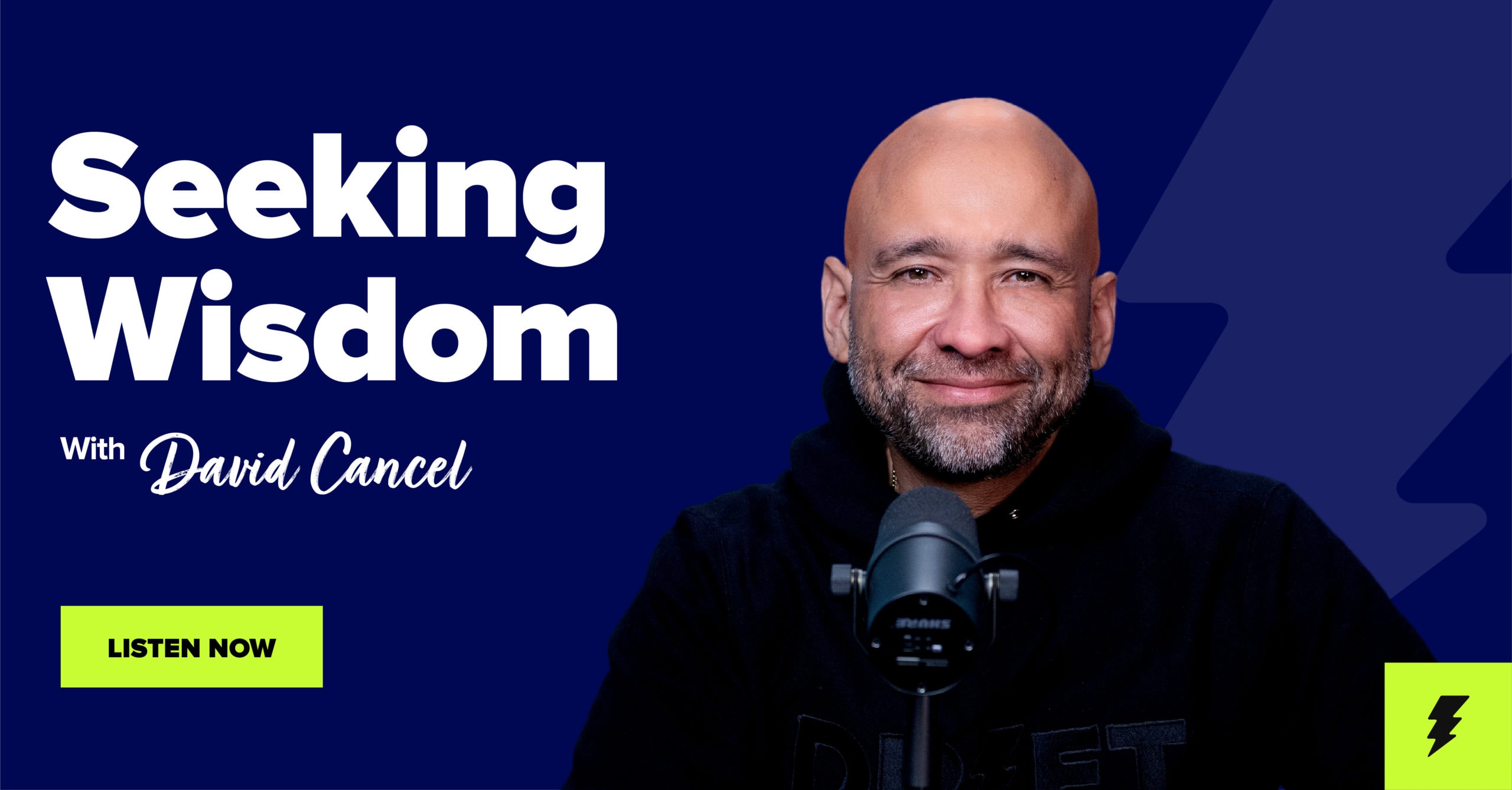If you want to lead people, there’s only one book you need to read.
Seriously.
Sure, there are a lot of other books out there about management and leadership that are entertaining, but they’re all built on top of this one book.
It’s a book written by the OG of management, Peter Drucker. It’s called The Effective Executive: The Definitive Guide to Getting the Right Things Done, and it was first published back in 1966.
This book has stood the test of time and has everything you need as a manager to be able to grow and be an effective leader. It’s a book I give to all of our managers here at Drift (and before COVID came along, I made them keep it on their desks in the office).
I love this book so much that we once spent a whole episode of Seeking Wisdom to break the book down and unpack the top five management lessons that Drucker outlined. You can listen to the full episode below, or keep scrolling for the lessons.
1. Effective executives know where their time goes.
☝ Tweet This
This lesson is all about being proactive about the time that you have.
According to Drucker, the question you have to ask yourself is, “What would happen if this was not done at all?” And if the answer is nothing would happen, then obviously you have to stop doing that thing.
It’s all about first principles, it’s all about big rocks, it’s all about focusing on that one thing. As Drucker wrote, “It’s amazing how many things busy people are doing that will never be missed.”
Another point to consider here: You need to look for patterns. To quote Drucker, “A crisis that recurs a second time is a crisis that must not ever occur again.”
It’s okay if it came up the first time, it’s okay if we made a mistake, or if we missed something. But if it keeps recurring – that same pattern over and over – then the flaw is not in that mistake itself. The flaw is in the management of that and the fact that we’re letting that happen over and over and we’re not learning.
One final point when it comes to time management: Adding more people rarely helps. In fact, the biggest time-wasters often result from over-staffing. As Drucker wrote:
A workforce may indeed be too small for the task, and then the work suffers if it gets done at all. But this is not the rule. Much more common is the workforce that’s too big for effectiveness. The workforce that spends, therefore, an increasing amount of time interacting rather than working.
This is why at Drift we believe in the distributed teams approach, and keeping the teams small, what Jeff Bezos calls the two-pizzas-per-team rule that he has at Amazon. Adding more people to the mix almost never solves the problem faster. Instead, it only creates more process, more meetings, and more overhead, and it actually slows the entire thing down.
And there was Peter Drucker, before the two-pizza-team rule, before you heard it from me, before you read it anywhere else, Peter Drucker had it in his book.
Want to learn more about the processes that have made Amazon what it is today? Check out my interview with Colin Briar and Bill Carr 👇
2. Effective executives focus on outward contribution.
☝ Tweet This
Translation: It’s all about the results.
I love when people put in the effort. But it’s not about effort. It’s about results. And those results can be achieved by brute-forcing your way, or by actually having a smarter approach to things.
I often talk about working hard, because that is the basic thing you need to do, which most people fail to do. And when I do that people bring up, “Oh, it’s not about working hard, it’s about working smarter.” But to me, that’s obvious. Obviously, we need to work smart. Obviously when I’m saying “work hard,” I’m not saying “work dumb.”
The key is to do both things: to work hard and to work smart. But in the end, the way that you measure success is not in the effort, but in the results.
As a manager, you’re always asking, “What can I contribute?” But that’s not personal to you, it’s about the organization. That’s the servant-leadership approach, which is your job as a manager – it’s to serve your team and the organization. And that’s the question you should be asking: Not “What can you provide?”– but “What can you provide others in order for them to be effective?”
3) Effective executives make strength productive.
☝ Tweet This
This is something we talk about all the time at Drift: shoring up your weaknesses vs. doubling down on your superpowers.
The first part is identifying your superpower, then doubling down on it. And that’s what Drucker’s lesson here is about: Leaning into your core strengths, making them super strengths, and then surrounding yourself with people who are equally strong in other dimensions where you are weak. That is the key.
Take any team sport as an example, whether it’s basketball, football, whatever sport, and imagine if everyone on the team had exactly the same skill. So if everyone was the quarterback, if everyone wanted to be Tom Brady – that’s not a team. They probably couldn’t score very well if everyone wanted to throw the ball.
Same thing if everyone wanted to be able to be great at every position. It wouldn’t work so well. You have specialties. And people are specialized in that thing, and together, they form a cohesive team.
To quote Drucker:
To make strength productive is the unique purpose of organization. It can’t, of course, overcome the weaknesses with which each of us in abundantly endowed. But it can make them irrelevant.
One thing to keep in mind: Strong people always have strong weaknesses. Your superpower is also your super weakness.
Let’s take my co-founder Elias as an example. His superpower is that he’s very extroverted, so he likes to talk to people, and he likes to jump in the middle of chaos and try to bring order to the chaos. And that’s amazing.
But that same superpower, of having that strength in that context, is also his weakness. Because he does not naturally have the capacity to stay in his head or to not maybe want to turn every situation into a chaotic one where then he can jump in. And so it becomes this super weakness.
One more point to consider when it comes to making strength productive: When hiring, most managers try to fill a job description instead of looking for the right role for a specific person. The 10x people, the people who are capable of becoming 10x people, are almost never going to fit into some preconceived job description that you have. And those are the ones that you’re going to need to take big bets on.
In my career, most of the people who have been the 10x, 100x return people, have been people who didn’t fit perfectly into the role we were looking for. The point is that there’s something about them that looks like they have 10x capabilities. There might not be any role for them, but let’s look and see if we can build a role around them. Because usually those people who are 10x aren’t coming in through the normal process and aren’t fitting into the normal role.
You can get more of my thoughts on hiring and building teams in my episode with Leo Tenenblat👇
4. Effective executives concentrate on the few major areas where superior performance will produce outstanding results.
☝ Tweet This
Translation: Focus, focus, focus.
I had this conversation this week with a friend, which made me think about this. At Drift, we’re going through this scaling process right now. We’re trying to scale the company and the team.
Now, you can try to do two things at once: scale and optimize. You can have most of the people at the company focus on scaling – repeating what in the past has been working. And then a small group can be experimenting at the same time.
But you can’t have the people who are trying to scale and repeat also experiment at the same time. Because it’s all about focus, focus, focus.
For the to-do list people out there, you might have five things you need to get done in a day. But there’s usually always one thing that if you get that one thing done in the day, that’s going to 10x your day. That’s where your focus should be.
5. Effective executives, finally, make effective decisions.
☝ Tweet This
The big takeaway from this chapter can be summed up in two words:
Making effective decisions is all about no consensus. I hate consensus. That’s one of our leadership principles here at Drift: No consensus. Because we want to be able to do the 10x ideas, the ones that are really going to move the company forward, and those are usually the ones that can’t be created through consensus.
Consensus regresses us back to “just good enough” – it’s something that everyone can agree upon. The least offensive option.
The solution: Pick a directly responsible individual and let her or him make the decision and take the responsibility. Let them have the accountability and autonomy to make that decision. And then move forward.
Catch up on Seeking Wisdom episodes you missed here.
Editor’s Note: This article was published in January 2018 and has been updated to reflect new information.









